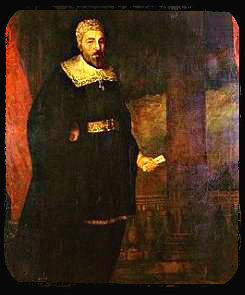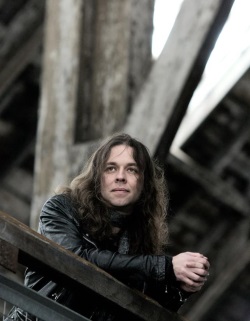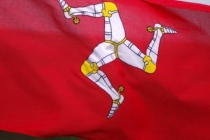Far more than a thing of ‘rags and patches’: Illiam Dhone and the Manx Nation by Dr John Callow

Illiam Dhone (14 April 1608 - 02 January 1663) also known as William Christian was a Manx politician and patriot. For his part in the Manx rising of 1651 he was executed by firing squad at Hango Hill in the Isle of Man on 2nd January 1663.
Every year on 2nd January there is a commemoration held at Hango Hill, which is an ancient place of execution. The ceremony is jointly organised by Mec Vannin (the Manx Nationalist Party) and the Mannin Branch of the Celtic League. One of the speakers at this year's 2018 gathering was historian and author Dr John Callow. In his oration he made it clear that IIliam Dhone's legacy should be celebrated. Printed below is the speech that John Callow prepared for the commemoration which gives an historical assessment of Illiam Dhone and the wider and relevant implications of his legacy.
Far more than a thing of ‘rags and patches’: Illiam Dhone & the Manx Nation by Dr John Callow
A death is far easier to order than to choreograph; and the truth always has an awkward way of getting out. The snap of musketry that ended William Christian’s life – 355 years ago today – on this small hill overlooking the Irish Sea, was intended as a grim warning to the ‘little Manx nation’ (and to the English soldiers of the Republic who had made common cause with them), that the days of autonomy, possibility, and religious freedoms were over.
Let us think for a moment of that chill January morning; of the prisoner marched under guard from Castle Rushen; of the cart following behind that would – later in the day – be used to transport his corpse back for burial at the kirk where he had worshipped for most of his adult life. The choice of place was carefully calculated: the boundaries of Christian estate ran right up to the base of Hango Hill; the gates of his own manor house at Ronaldsway were only a few hundred yards distant; and clearly visible to the west was Castletown, the centre of Manx government and home to the House of Keys, where – at the height of his power – ‘Brown Haired William’, Illiam Dhone to Gaelic speakers, had made laws, collected tithes, and administered justice. To the east, guarding the anchorage, lay the coastal fort of Derbyhaven, a potent symbol of the might of the Stanley family whom he had once served and had, latterly, come to oppose with every fibre of his being. We do not know if John Lace and his young wife – two of the first Quakers on the Isle – were among the crowd that gathered to witness his end. Their farm at Hango was about to be seized by the authorities and their cattle turned-out along the beach; for they were not only religious dissenters but supporters of both the English Republic and of Illiam Dhone. Similarly, we do not know if Maximilian Bostocke – a former sergeant of the garrison discharged for his part in the 1659 rising – or his young ward, Jane Hathorne, were present. They would certainly have heard the gunshots from their homes and hearths, and would have been in no doubt that the authorities (in the form of the restored Stanleys and the Prince Bishops) also had them in their sights. These figures, silenced and forgotten within the court records, are central – as we shall see – to the story and to the real achievements of Illiam Dhone’s life.

If there is much that is now unrecoverable, we can be sure that the execution was staged as an unambiguous piece of political theatre amid the widespread repression that followed the return of monarchy and the Lord of the Isle in 1660-61. It served not only as a stark warning to any future rebellious subjects, but also stood as ruthless testimony to Charles Stanley, 8th Earl of Derby’s determination to maintain his family’s hold over the politics of the Isle and to resist any attempt at outside interference in his affairs. We also know that among the crowd, at Hango Hill on 2 January 1663 was the vicar of Malew Kirk who recorded that fact that William Christian – one-time Governor and Receiver General of the island – went to his death most courageously, refusing the offer of a blindfold and addressing – directly – his own people with an ‘excellent speech’, words to inspire and hearten in the darkest of times. He made what the Seventeenth Century understood to be ‘a good end’ – and this was exceptionally important in an age where death was a public act rather than a private matter.
As a consequence, William Christian – man of wealth, taste and politics – became Illiam Dhone, the selfless, martyred patriot, of whom souvenirs were sought, stories told and a famous ballad written. In short, he became the stuff of legend. Tales of his death were embroidered: blankets had been laid beneath his feet so that his blood did not fall upon the hillside; his corpse was not disfigured by the murderous bullets; and a soldier of the firing squad who profited from the sequestration of his estates was cursed, with his family falling upon bad times. Yet, if this is mythic afterlife of the foremost national hero of Man; what were the nature of his achievements? What did he do for his people? Why do we continue to honour him, on this day?
When confronted with the reality, of governmental records and account books, some writers have felt let down. One Manx historian thought William Christian no more than ‘a thing of rags and patches’ and too much time has been wasted, and ink spilled, on the question of his supposed ‘betrayal’ of the aristocratic Stanleys. However, once we place him back within his own historical context the significance and accomplishments of William Christian/Illiam Dhone become all-too evident and striking.
For the remainder of this talk, I wish to explore three themes that bear this thesis out.
The first is located in the collapse of Stanley power after the defeat of the 7th Earl of Derby at the battle of Wigan Lane. The English invasion fleet that anchored off Ramsay Bay, on 26 October 1651, had come to fight! It intended – and expected - to encounter and overthrow a heavily armed, well-motivated and firmly entrenched Royalist enemy that sought no compromise and had, in the past, been reluctant to take prisoners. In the minds of all were memories of the recent campaigns in Ireland, characterised by heavy losses in both military and civilian lives, and by the destruction of property, cultural artefacts, language and a distinct Celtic identity.
Yet, this did not happen on Man. And it was largely due to the actions and credit of William Christian.
The warships were hailed in the dark by ‘one Hugh More an Islander’ who had come on the business of ‘Mr. Receiver Christian, and others the chief of the Island’. Once on board the flagship, William Christian wasted no time in explaining to the surprised soldiers that the country was already in arms: that the Manx had risen against the increasingly autocratic rule of the Stanley family, that the outlying garrisons had already been taken and that only Peel and Rushen castles stood out against them. Christian then offered the help of the islanders to the forces of the English Commonwealth if – and it was a very big ‘if’ - the ‘poor Island might be preserved from spoil, and the Inhabitants from undoing’ so that they might continue to ‘enjoy their lawes and liberties as formerly they had’. All of a sudden, the Manx nation had become – under Christian’s leadership – a forceful political actor in its own right, capable of bargaining with the military leaders of a resurgent English state. As a consequence, William Christian delivered a bloodless coup d’etat and a reordering of power on the Isle that protected Man, its people and its language, from becoming assimilated, at once, into the Commonwealth of England.
His second stroke of genius was in his formulation of the promise given by the Commonwealth to abide by the island’s pre-existing ‘laws and liberties’. Illiam Dhone knew full-well that freedoms were in short supply on Man during the Civil War years but he used a recourse to a tradition – a tradition that never really existed – in order to create and drive forward a radical programme of government for the Isle that guaranteed an unprecedented degree of autonomy for its indigenous Gaelic people, between 1651-59. To do this, a tripartite alliance was forged between Christian and the Manx; the civilian administrators (largely drawn from the West Riding of Yorkshire) appointed by Thomas, Lord Fairfax; and the highly politicised garrison soldiers left behind by the English army. This settlement was durable and highly effective, and collapsed largely due to external factors – namely, the slide towards the disillusion of English Republican government and the capitulation of Fairfax’s power – rather than through any inherent weakness or flaws.
The third achievement of William Christian lay in the realm of extending possibilities and imagination to all those who lived upon the Isle. There was a recognition from the pens of writers as different as Samuel Rutter, William Blundell and James Chaloner that, in their discoveries of Man and the Manx, they had found something precious, appealing, fragile and very ‘different’ to that which they had known before. It was in this space – of freedom to think and to dream – that a substantial portion of the English garrison accepted an Anglo-Manx identity, with veterans like Sergeant Bostocke – opening businesses in Peel and intermarrying, or at least cohabiting with local women, and coming to learn and to respect the language and the people whom they had originally been intended to police. It meant for the Lace family the opportunity of religious expression and the chance to voice ideas of religious and sexual democracy. For Jane Hathorne it was encapsulated in her father’s dying wish that she (he was silent about his hopes for her younger brothers) should be taught to read, to write, and to think for herself. There can be few more bitter testimonies to the sea change marked by the Restoration than the attempts to wrest her property away from her; or of the shrinking of Manx horizons in that when she came to inherit her estate – preserved for her by Bostocke’s tenacious and protracted legal fight with the authorities – she marked her assent with a single cross, rather than by her signature.
One could dwell upon that sense of loss at length, but Hango Hill – and our commemoration of Illiam Dhone – should not be a maudlin affair, calculated to ‘break our hearts’. Instead, it should be a celebration of that which was secured at so much peril and cost, and of that which still needs to be achieved through struggle, in the present, if we are to honour the spirit of Christian and his comrades in deeds as well as in words. It is therefore fitting that William Christian ‘the great rebel’ came to be most famously recalled not through grand monuments or academic tracts; but through a work of art and verse; a ballad in the Manx tongue that stands as the first avowedly political, polemical and democratic text in the Manx language. That is the testimony of his greatness, lying in the quality of his resistance and the breadth of his vision for his people. It is expressed through art and negotiation, rather than through war and conquest; and through the attainment of prosperity for all of the Manx nation as opposed to the want of the many and exploitation in favour of the few. It enshrines dignity and self-determination, rather than passivity and subjugation. It is about ideas, rather than status. Consequently, when viewed in this light, Illiam Dhone is a figure cloaked not so much in rags and tatters as by fabrics coloured like so many bright stars, fashioned from the hopes and dreams of his people, both then and now. Indeed, there are few better legacies to be had.
Further reading
Interview with John Callow on Illiam Dhône
- Manx
- English






